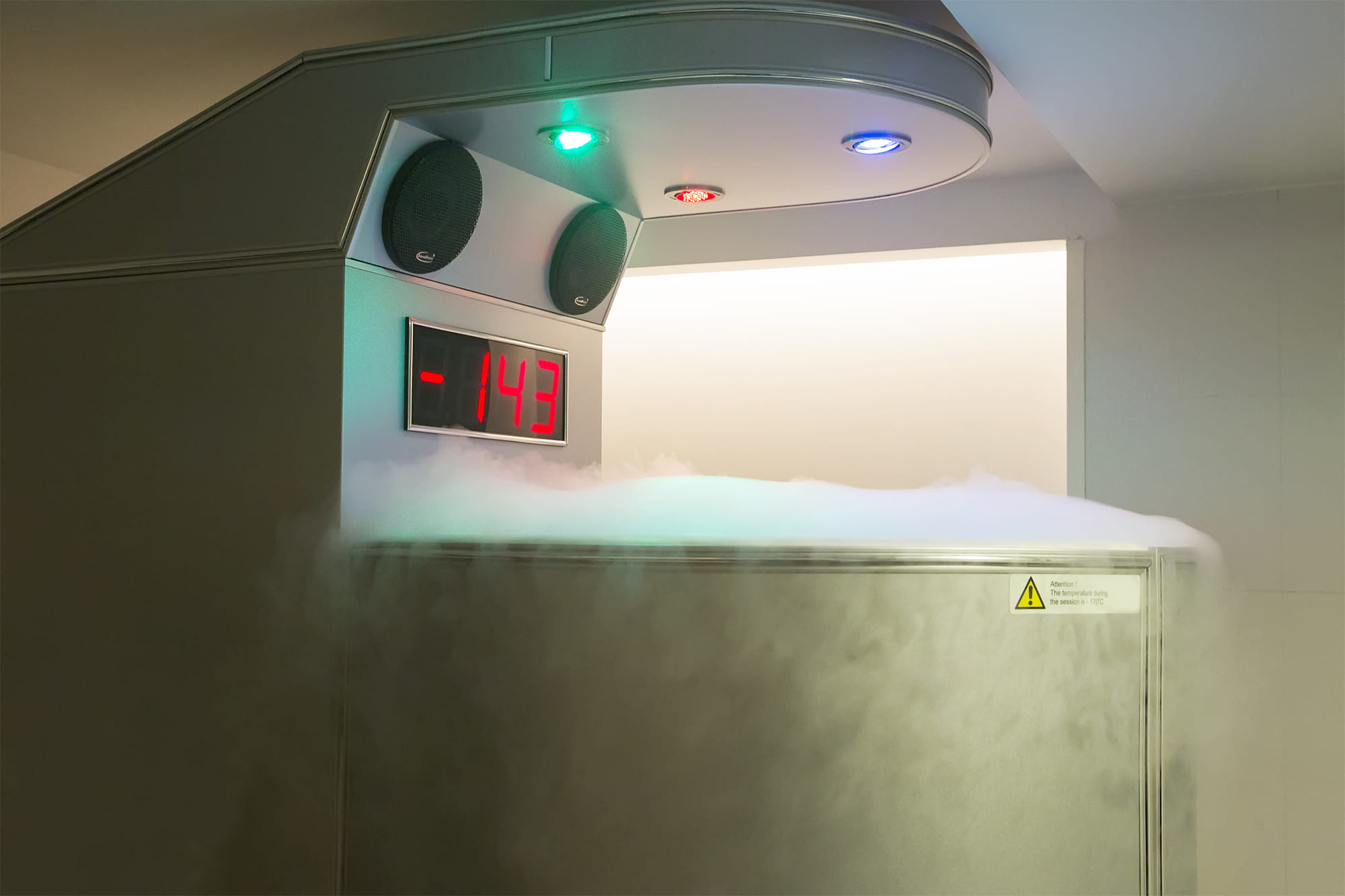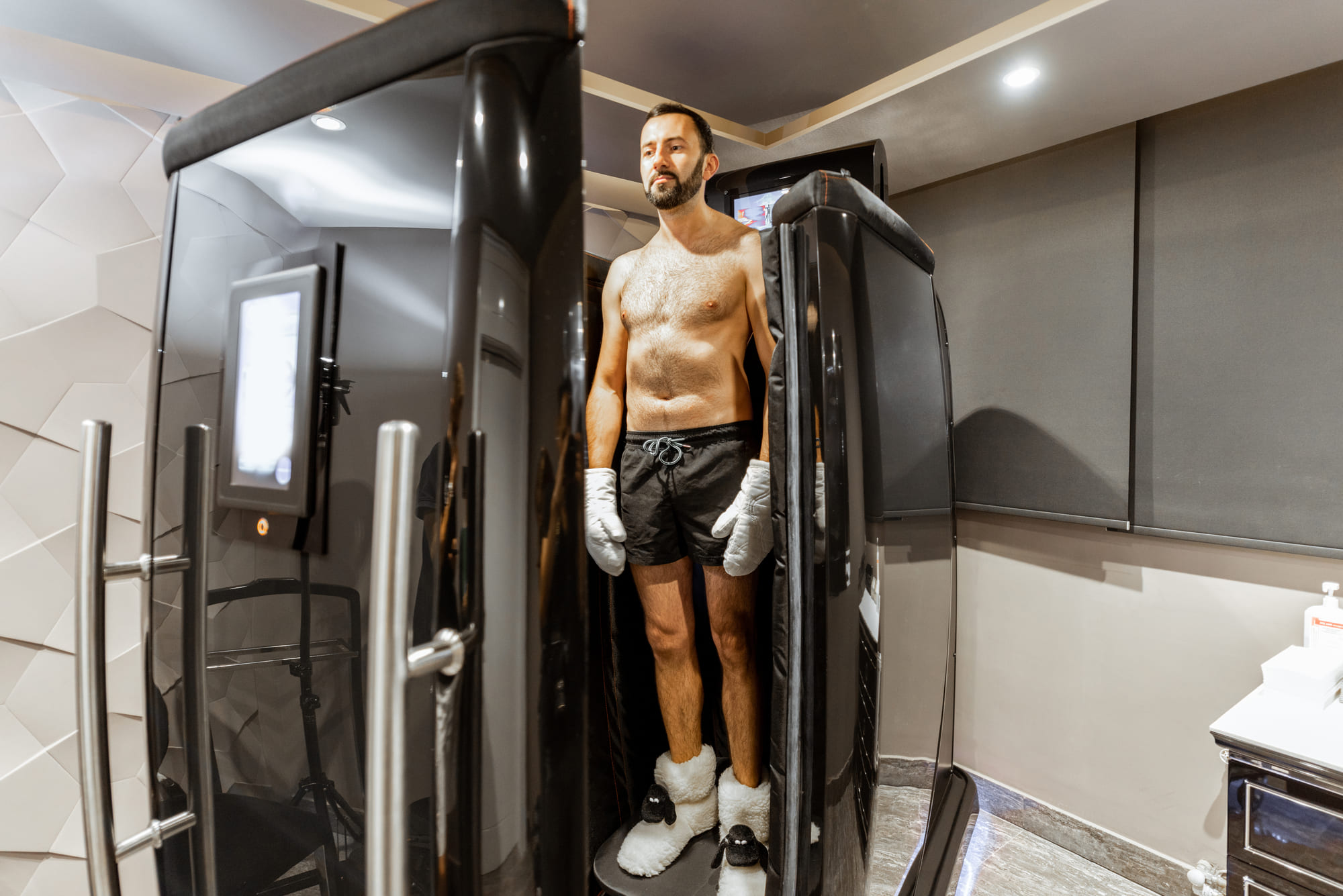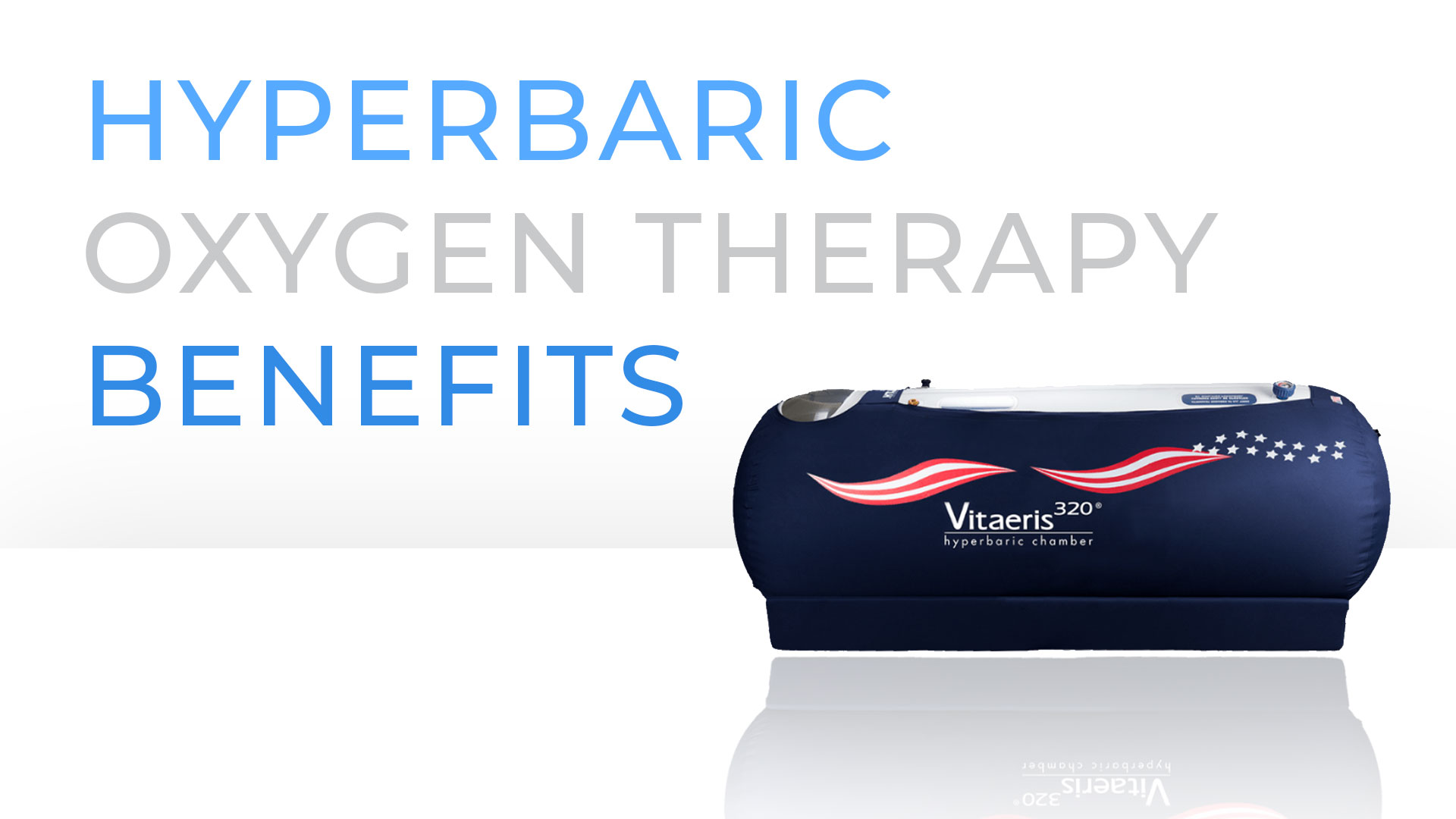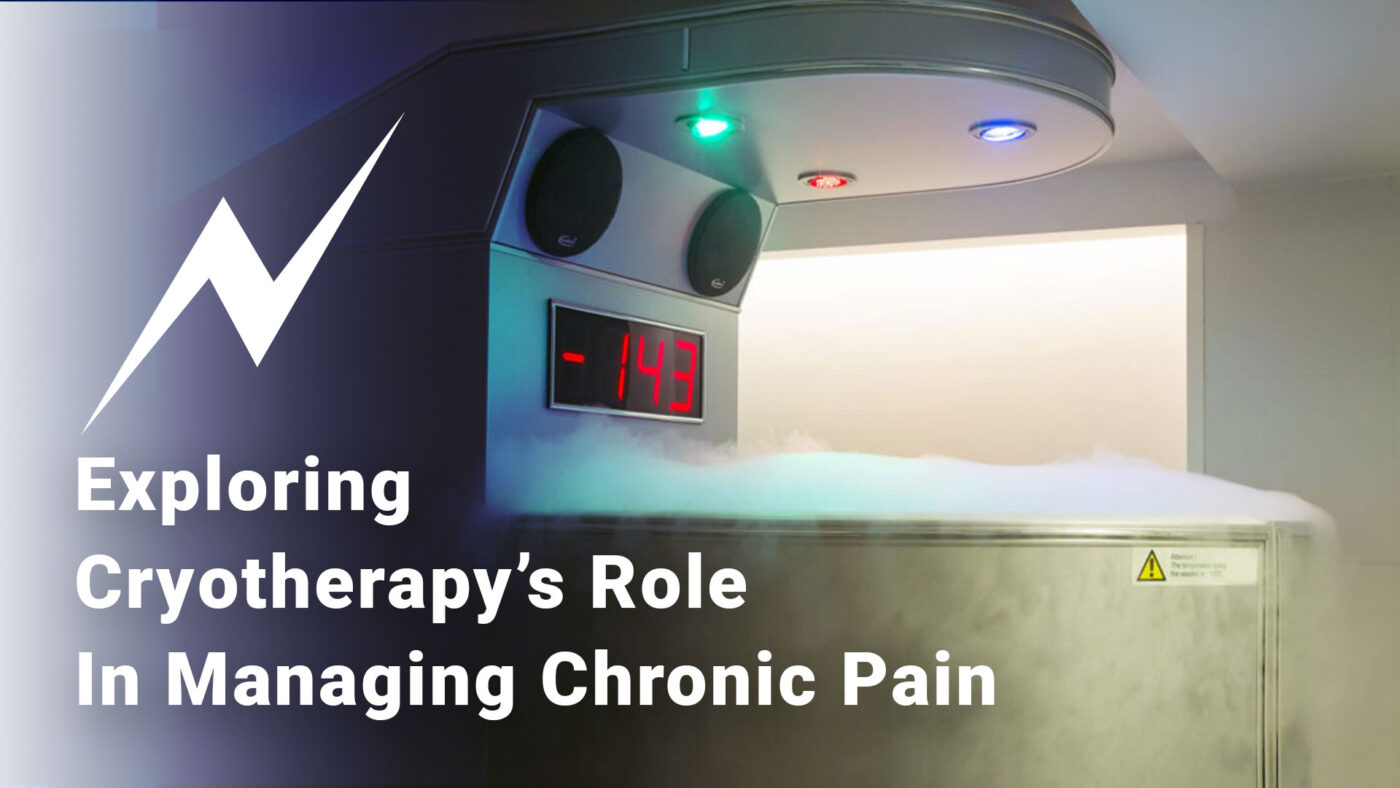
Chronic pain affects millions globally, undermining the quality of life and posing a significant challenge to healthcare systems. Characterized by persistent pain that lasts weeks to years, chronic pain can originate from various conditions, including arthritis, fibromyalgia, back issues, results of car accidents and traumatic injuries, and other causes. This relentless discomfort not only wears down physical strength but also impacts emotional and mental well-being, leading to a desperate search for effective management strategies.
In the quest for relief, cryotherapy emerges as a beacon of hope. This innovative treatment, involving exposure to extremely cold temperatures for therapeutic purposes, offers a novel approach to pain management.
This blog post aims to delve into the intricacies of cryotherapy, exploring its historical roots, mechanisms of action, application in chronic pain management, benefits, safety considerations, and how it compares with other pain management methods. By providing a comprehensive overview, we aim to illuminate the potential of cryotherapy as a component of a holistic pain management strategy.
Understanding Cryotherapy
Cryotherapy is not a new concept; it has been utilized in various forms for centuries, with historical records¹ indicating its use in ancient Egypt, Greece, and Rome for pain relief and inflammation reduction. The modern incarnation of cryotherapy, particularly whole-body cryotherapy (WBC), was developed in Japan in the late 1970s by Dr. Toshima Yamauchi as a treatment for rheumatoid arthritis. Since then, its application has expanded, gaining popularity in Europe and North America for its wide range of health and wellness benefits.
Cryotherapy can be categorized into two primary types: whole-body cryotherapy (WBC) and localized cryotherapy. WBC involves exposing the entire body to ultra-cold air in a cryochamber, with temperatures ranging from -166°F to -220°F, for a brief period, usually between two to four minutes. On the other hand, localized cryotherapy targets specific areas of the body using devices that emit cold air or liquid nitrogen, focusing the cold's effects where they are needed most.
The principle behind cryotherapy is the body's natural response to cold. When subjected to the extreme cold temperatures characteristic of cryotherapy, the body initiates several protective and healing mechanisms:
- Vasoconstriction: Blood vessels in the skin and peripheral tissues narrow, a process known as vasoconstriction, reducing blood flow to those areas. This response helps to minimize heat loss and reduces inflammation by limiting the flow of inflammatory mediators to the site of injury or pain.
- Analgesic Effect: The cold temperature can numb nerves, slowing down the transmission of pain signals to the brain. This analgesic effect provides immediate relief from discomfort, making cryotherapy an attractive option for acute injury management and chronic pain conditions.
- Reduced Metabolic Rate: Exposure to cold can decrease the metabolic rate of cells, reducing their oxygen requirements. This can help in preserving cells and tissues in states of injury or trauma.
- Activation of the Sympathetic Nervous System: The cold stimulates the sympathetic nervous system, triggering the release of endorphins, the body's natural painkillers and mood elevators. This response can lead to improved mood and general well-being, alongside its pain-relieving effects.
Cryotherapy in Managing Chronic Pain
The application of cryotherapy in chronic pain management is supported by a growing body of research and clinical observations. Conditions such as rheumatoid arthritis, chronic back pain, fibromyalgia, and more have been the focus of studies examining cryotherapy's efficacy. Patients with rheumatoid arthritis, for example, have experienced significant reductions² in joint pain and stiffness, along with improvements in mobility after undergoing WBC treatments. Similarly, individuals suffering from chronic back pain and fibromyalgia³ have reported not only reduced pain levels but also enhanced sleep quality and overall quality of life following cryotherapy sessions.
These outcomes are attributed to cryotherapy's ability to dampen pain through its anti-inflammatory effects, reduction of nerve activity, and the slowing down of pain signal transmission. Furthermore, cryotherapy's impact on enhancing endorphin release plays a crucial role in its pain-relieving capabilities.
Benefits of Cryotherapy for Chronic Pain
Cryotherapy offers multiple benefits for individuals suffering from chronic pain beyond the immediate relief of discomfort:
- Improved Inflammatory Response: Regular exposure to cold can modulate the body's inflammatory processes, leading to a more balanced immune response. This can be particularly beneficial for chronic inflammatory conditions like rheumatoid arthritis.
- Decreased Nerve Activity: The cold temperatures help to slow the transmission of pain signals in the nerves, providing a natural analgesic effect.
- Enhanced Circulation: After the initial vasoconstriction response, blood vessels dilate, a process known as vasodilation. Repeated cycles of vasoconstriction and vasodilation can improve overall circulation, aiding in the removal of metabolic waste and the delivery of oxygen and nutrients to tissues.
- Improved Mobility: Reduction in pain and inflammation often results in better mobility and physical function, enabling individuals to engage more fully in daily activities and exercise.
- Enhanced Well-being: The stimulation of endorphin release can improve mood and create a sense of well-being, providing a psychological boost that is often needed by those dealing with chronic pain.
Improved Sleep Patterns: Many individuals report better sleep quality after cryotherapy sessions, which is essential for overall health and well-being. - Increased Antioxidant Capacity: Some research suggests that cryotherapy can enhance the body's antioxidant defenses, protecting against oxidative stress, which is implicated in a variety of chronic diseases and conditions.
- Stimulation of Brown Fat Activity: Exposure to cold has been shown to stimulate brown fat, a type of body fat that generates heat to maintain body temperature. Activated brown fat improves the body's ability to burn calories, which can contribute to weight management.
Research supports these benefits, highlighting cryotherapy's role in enhancing the quality of life for those with chronic pain. For instance, a study on WBC's effects on patients with rheumatoid arthritis found significant improvements in disease activity scores, suggesting a decrease in pain and inflammation.
Psychological and Systemic Effects
Beyond its physical effects, cryotherapy has been associated with various psychological and systemic benefits, including reduced symptoms of anxiety and depression, improved sleep patterns, and a general sense of wellbeing. These effects are attributed not only to the physiological responses triggered by the cold but also to the enhanced release of endorphins and improved sleep quality following treatments.
Understanding the science behind cryotherapy and its multifaceted effects on the body helps to appreciate its potential as a therapeutic modality for chronic pain management, recovery, and overall health optimization. While the immediate chilling sensation may be the most noticeable aspect of cryotherapy, the real value lies in the body's complex, adaptive responses to cold, offering relief and rejuvenation from the inside out.
Considerations and Precautions
Comparing Cryotherapy with Other Pain Management Techniques
When considering cryotherapy in the context of other chronic pain management methods, it's important to weigh its advantages and disadvantages. Traditional pain management strategies include medication, physical therapy, acupuncture, and more invasive procedures like surgery. Cryotherapy presents a non-invasive alternative or complementary option that has distinct benefits:
- Non-Pharmacological: Cryotherapy offers a drug-free method to manage pain, reducing the risk of medication side effects and dependency.
- Quick and Convenient: Sessions are short, typically only a few minutes, with minimal preparation and recovery time needed, making it a convenient option for many.
- Holistic: Beyond pain relief, cryotherapy can offer overall wellness benefits, including improved mood and sleep, which are not typically addressed by conventional pain management methods.
However, cryotherapy may not be the best stand-alone treatment for everyone. The effectiveness of cryotherapy can vary depending on the individual and the nature of their chronic pain condition. It's often most effective when used as part of a broader, comprehensive pain management plan that may include physical therapy, exercise, and medication as recommended by healthcare professionals.

Practical Tips for Incorporating Cryotherapy into Pain Management
Before Your Session
- Consult with Your Healthcare Provider: Before starting cryotherapy, especially for chronic pain or health conditions, discuss it with your healthcare provider to ensure it's safe and appropriate for you.
- Wear Proper Clothing: For whole-body cryotherapy, you'll typically be provided with special gloves, socks, and footwear to protect your extremities from the cold. Wear dry, loose-fitting clothing, and remove any metal jewelry to prevent cold burns.
- Stay Hydrated: Being well-hydrated before your session can help improve circulation and enhance the detoxifying effects of cryotherapy.
- Avoid Lotions and Moisture: Do not apply lotions, oils, or moisture to your skin immediately before a session, as this can increase the risk of frostbite.
- Eat a Light Meal: Having a light meal a couple of hours before your session can ensure that you have enough energy and prevent any light-headedness during the treatment.
During Your Session
- Breathe Deeply and Relax: The initial shock of the cold can be intense. Focus on taking slow, deep breaths to relax your body and mind, making the experience more comfortable and less shocking.
- Stay Mindful: Pay attention to your body's responses to the cold. While discomfort is normal, you shouldn't feel pain. Communicate with the technician if you feel too uncomfortable.
- Move Gently: If permitted, gently rotate your body or move your limbs to maintain circulation without causing undue stress or movement that could make the cold feel more intense.
After Your Session
- Warm Up Gradually: After your session, your body will begin to warm up naturally. Engage in light exercise, like walking, to promote circulation if recommended by the cryotherapy provider, but avoid rushing into intense physical activity immediately.
- Hydrate: Drink water to help flush toxins from your body and continue the process of rehydration after the cold exposure.
- Note Your Body's Response: Keep track of any changes you notice in your pain levels, mood, energy, and sleep quality in the hours and days following your session. This can help you determine the effectiveness of the treatment and optimize the timing and frequency of future sessions.
- Follow a Healthy Lifestyle: To maximize the benefits of cryotherapy, incorporate it into a holistic approach to health and wellness that includes a balanced diet, regular exercise, and sufficient rest.
- Consult with the Cryotherapy Provider: After your session, discuss your experience with the provider. They can offer personalized advice and adjustments for future sessions to ensure you receive the maximum benefit. They will likely advise you to start gradually, follow pre- and post-session guidelines, and monitor your responses for adverse reactions so that you can adjust your treatment plan as necessary.
By preparing adequately, focusing on relaxation and mindfulness during the session, and adopting healthy practices afterward, you can enhance the effectiveness of cryotherapy and enjoy the wide range of benefits it offers.
Conclusion
Cryotherapy represents a fascinating intersection of ancient therapeutic principles and modern technology, offering new hope for individuals battling chronic pain. By leveraging the body's natural responses to cold, cryotherapy can provide significant relief from chronic pain, improve mobility, and enhance overall quality of life. As with any treatment, the key to success lies in a personalized approach, considering individual needs, conditions, and responses. With ongoing research and clinical observation, the potential of cryotherapy in chronic pain management continues to unfold, promising a cooler path to pain relief.
Get started on your pain relief journey today by booking a session with ReEnergized.
We invite readers to share their experiences with cryotherapy in the comments section below. Whether you're considering cryotherapy for chronic pain or have already experienced its chilling embrace, your insights can help others navigate their journey toward relief. For those pondering cryotherapy, we encourage you to consult with a medical professional to discuss its suitability for your specific situation. Let's continue the conversation and explore the potential of cryotherapy together.
Frequently Asked Questions
Cryotherapy represents a fascinating intersection of ancient therapeutic principles and modern technology, offering new hope for individuals battling chronic pain. By leveraging the body's natural responses to cold, cryotherapy can provide significant relief from chronic pain, improve mobility, and enhance overall quality of life. As with any treatment, the key to success lies in a personalized approach, considering individual needs, conditions, and responses. With ongoing research and clinical observation, the potential of cryotherapy in chronic pain management continues to unfold, promising a cooler path to pain relief.
Get started on your pain relief journey today by booking a session with ReEnergized.
We invite readers to share their experiences with cryotherapy in the comments section below. Whether you're considering cryotherapy for chronic pain or have already experienced its chilling embrace, your insights can help others navigate their journey toward relief. For those pondering cryotherapy, we encourage you to consult with a medical professional to discuss its suitability for your specific situation. Let's continue the conversation and explore the potential of cryotherapy together.
How much does cryotherapy cost?
How long does a cryotherapy session last?
How often should I undergo cryotherapy for chronic pain?
What can I expect in terms of outcomes?
Outcomes can vary, but many individuals report improvements in pain levels, reduced inflammation, enhanced mobility, and overall well-being after a series of cryotherapy sessions. It's important to have realistic expectations and understand that cryotherapy may be most beneficial as part of a comprehensive pain management plan.
Is cryotherapy safe for everyone?
Citations:
- BSc, N. B, & Freiman, A. (2005). History of cryotherapy. Dermatology Online Journal, 11(2). http://dx.doi.org/10.5070/D34f62h9vt Retrieved from https://escholarship.org/uc/item/4f62h9vt
- Klemm, P., Hoffmann, J., Asendorf, T., Aykara, I., Frommer, K., Dischereit, G., Müller-Ladner, U., Neumann, E., & Lange, U. (2022). Whole-body cryotherapy for the treatment of rheumatoid arthritis: a monocentric, single-blinded, randomised controlled trial. Clinical and experimental rheumatology, 40(11), 2133–2140. https://doi.org/10.55563/clinexprheumatol/lrff6k
- Varallo, G., Piterà, P., Fontana, J. M., Gobbi, M., Arreghini, M., Giusti, E. M., Franceschini, C., Plazzi, G., Castelnuovo, G., & Capodaglio, P. (2022). Is Whole-Body Cryostimulation an Effective Add-On Treatment in Individuals with Fibromyalgia and Obesity? A Randomized Controlled Clinical Trial. Journal of clinical medicine, 11(15), 4324. https://doi.org/10.3390/jcm11154324

What is Hyperbaric Oxygen Therapy?
Hyperbaric oxygen therapy, also known as HBOT, is a wellness therapy in which a person breathes pure oxygen in a pressurized chamber. This therapy is typically administered in a hyperbaric chamber, which can be a monoplace chamber designed for a single person or a multiplace chamber that can accommodate multiple individuals. The chamber is pressurized to levels higher than atmospheric pressure, usually around 2 to 3 times normal atmospheric pressure. The primary mechanism of action of HBOT is to increase the amount of oxygen dissolved in the bloodstream, which can promote various therapeutic effects.
Sessions usually last between 30 minutes and 2 hours, and frequency can vary depending on the specific concern being treated and the recommendations of the recipient's wellness advisor(s). In many cases, a standard course of treatment involves daily sessions, typically five days a week. The suggested total number of sessions can range from just a few to several weeks' worth, depending on the nature and severity of the issue the recipient seeks to address.
Hyperbaric Oxygen Therapy Benefits
- Increases Blood Oxygen Levels
- Stimulates Growth Factors and Stem Cells
- Improves White Blood Cell Activity
- Decreases the Size of Blood Oxygen Molecules and Increases Circulation
- Increases ATP Energy Molecule Production
- Stimulates Blood Vessel Synthesis and Proliferation
Hyperbaric Oxygen Therapy Applications
Wound Healing
Hyperbaric oxygen therapy can promote the healing of certain wounds, such as diabetic foot ulcers, non-healing surgical wounds, wounds resulting from traumatic injuries, and burns. In conditions like trauma-induced crush injuries, this works by increasing the amount of dissolved oxygen in the bloodstream through higher pressure. It also reduces bubble size and promotes various healing processes, including vasoconstriction to manage tissue swelling, collagen synthesis for wound healing, and angiogenesis for new blood vessel formation. Simultaneously, HBOT enhances the body's defense against bacteria by increasing oxygen free radicals and improving the effectiveness of certain antibiotics.1 Wound healing is common reason people receive HBOT in wellness studio settings such as ReEnergized, and is also widely recognized and implicated in emergency medical settings.
Fighting Infections
Hyperbaric oxygen therapy can also help fight bacterial and fungal infections, including more severe and treatment-resistant infections such as those resulting from diabetic wounds, surgical complications, and radiation-related complications. HBOT is particularly valuable when faced with any of the growing list of antibiotic-resistant pathogens, for those allergic or intolerant of antibiotics, and for anyone avoiding the overuse of antibiotics as a means of optimizing their natural immunity. Specifically, HBOT fights infection by slowing down or killing bacteria and boosting the immune system's natural ability to fight infections. Additionally, it works well alongside other infection-fighting treatments as a complimentary approach.2
Radiation Injury
Cancer patients often undergo hyperbaric oxygen therapy to reduce the side effects of radiation treatment on healthy tissues. These include thermal burns and the potentially-fatal sepsis infection than can result from them. HBOT has an extensive history of success in treating burns– in fact, scientists have known of its ability to reduce burn healing times and mortality rates for over half a century.3 While HBOT is known to treat infections like sepsis by fighting bacteria and boosting immunity, it treats burns by increasing the O2 levels in burned tissues.3
Treating Herpes Family Viruses
Common viruses in the herpes family include herpes varicella-zoster (chickenpox), herpes zoster (shingles), herpes simplex types I and II, and herpes meningitis. Like many viruses, they are anaerobic, meaning they thrive in environments without oxygen. By increasing bodily oxygen content and circulation, hyperbaric oxygen therapy has been shown to drastically accelerate herpes blister and lesion healing, relieve associated pain, and reduce the prevalence of certain symptoms associated with some herpes strains, such as neuralgia and depression.4
Treating Traumatic Brain Injury
Hyperbaric oxygen therapy has been demonstrated in numerous studies to have neuroprotective properties when administered to sufferers of traumatic brain injuries (TBI). It does this by improving preventing cell death, reducing inflammation, improving tissue oxygenation and cellular metabolism, and promoting the formation of new neurons and blood vessels in the brain.5
Treatment of Decompression Sickness and Carbon Monoxide Poisoning
One traditional application of hyperbaric oxygen therapy is to treat decompression sickness, also known as nitrogen gas embolism or 'the bends.' Decompression sickness is most commonly caused by ascending too rapidly after scuba diving, which leads to nitrogen gas bubble to formation within the affected person's blood vessels. Left untreated, decompression sickness can lead to severe side effects such as tissue damage, stroke, or heart attack, and can even be fatal.6 The pressurized environment in the hyperbaric chamber allows the increased atmospheric pressure to force more oxygen into the bloodstream, which helps to shrink, dissolve and eliminate the gas bubbles there. Simultaneously, the increased oxygen availability helps to support tissues that may be experiencing oxygen deprivation due to the blockage caused by gas embolisms. These are the same mechanisms by which HBOT speeds the removal of the noxious gas carbon monoxide from the bloodstream.
Treatment of Vascular Air Embolism
In contrast to decompression sickness, vascular air embolism (or VAE) occurs when the bubbles formed in the affected person's arteries are made up of air, as opposed to nitrogen. This usually occurs as a side effect of some routine medical procedures, such as the administration of fluids intravenously.7 The mechanisms by which HBOT treats gas embolisms and vascular air embolisms are generally similar. Both conditions involve the presence of gas bubbles in the bloodstream, which can obstruct blood vessels and lead to tissue damage. For both types of embolisms as well as carbon monoxide poisoning, HBOT should be administered in a timely manner for the best chance at preventing severe consequences, and treatment should not be completed before first receiving professional guidance from the recipient's emergency healthcare team.6, 7
Types of Hyperbaric Oxygen Therapy
If you're interested in hyperbaric oxygen therapy, you're probably wondering how someone receives this treatment. HBOT is usually administered in one of three different types of settings:
- Wellness Studios: Many wellness studios and holistic health practitioners offer hyperbaric oxygen treatments on their menus. Common reasons people seek treatment from these independent health centers include their desire to treat various infections, facilitate wound or injury healing, facilitate collagen formation, and to treat the symptoms of herpes viruses. You can search online or call nearby locations to see if they offer hyperbaric oxygen therapy and ask about pricing and availability.
- Clinical Medical Providers: Some hospitals, medical offices and clinics also offer HBOT as a treatment for certain conditions, such as non-healing wounds, severe infections resistant to conventional treatment methods, noxious gas poisoning, vascular gas embolism or decompression sickness, traumatic brain injuries, and gangrene. In this case treatment is either administered in an emergency setting, or the patient receives a referral from their primary care doctor to see a specialist.
- At-Home Devices: Of course, there are some who prefer the convenience of receiving chamber therapies at home, and have the necessary space and funds to invest in their own machine. While this option can be attractive, be forewarned– if inadequate training or insufficient focus lead to improper use, the consequences can be serious.8 Additionally, these at-home devices are usually inflatable rather than solid fixtures, and are typically smaller and less powerful than the ones used in professional settings. However they can still be effective for certain conditions.
Hyperbaric Oxygen Therapy Risks
The risks associated with hyperbaric oxygen therapy are generally considered to be rare when the treatment is administered appropriately by qualified, informed professionals. These include potential claustrophobia while laying in the chamber, anxiety, lightheadedness, fatigue, ear or sinus pressure or discomfort, and in cases where the recipient was in the chamber for too long, there have been cases of oxygen poisoning. HBOT is not recommended for pregnant women or individuals with middle ear barotrauma, uncontrolled high blood pressure, or acute or chronic respiratory conditions.
References
1. Hyperbaric oxygen and wound healing
2. Hyperbaric oxygen therapy: Antimicrobial mechanisms and clinical application for infections
3. Treatment of burns with hyperbaric oxygen (Article)
4. Effect of hyperbaric oxygen therapy on patients with herpes zoster
5. Hyperbaric oxygen therapy for traumatic brain injury: bench-to-bedside
8. Safety Precautions for HBOT at Home: What You Need to Know
Get In Contact
Call
Location
4434 E Pacific Coast Highway
Long Beach, California 90804
Hours
Monday - Friday
11:00AM - 07:00PM
Saturday - Sunday
11:00AM - 04:00PM
Get In Contact
Call
Location
4434 E Pacific Coast Highway
Long Beach, California 90804
Hours
Monday - Friday
11:00AM - 07:00PM
Saturday - Sunday
11:00AM - 04:00PM

